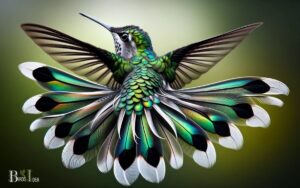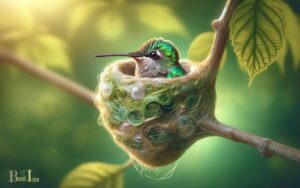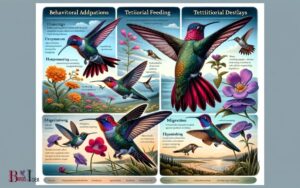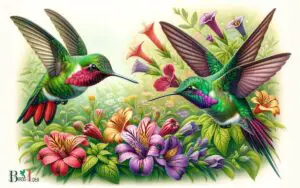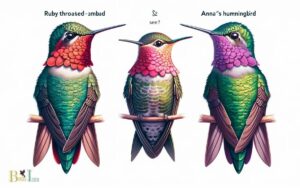Anna’s Hummingbird Scientific Name: Calypte Anna!
The scientific name for Anna’s Hummingbird is Calypte anna, is a species of hummingbird native to the western coastal regions of North America. This bird is named after Anna Masséna, Duchess of Rivoli.
Characteristics of Anna’s Hummingbird:
Anna’s Hummingbird is a remarkable species because of its ability to thrive in various habitats, including gardens and backyards. This has led to an increased range for the species, especially in urban settings.
The Calypte anna is renowned for its aerial agility, often seen performing breathtaking dives to attract mates or defend its territory.
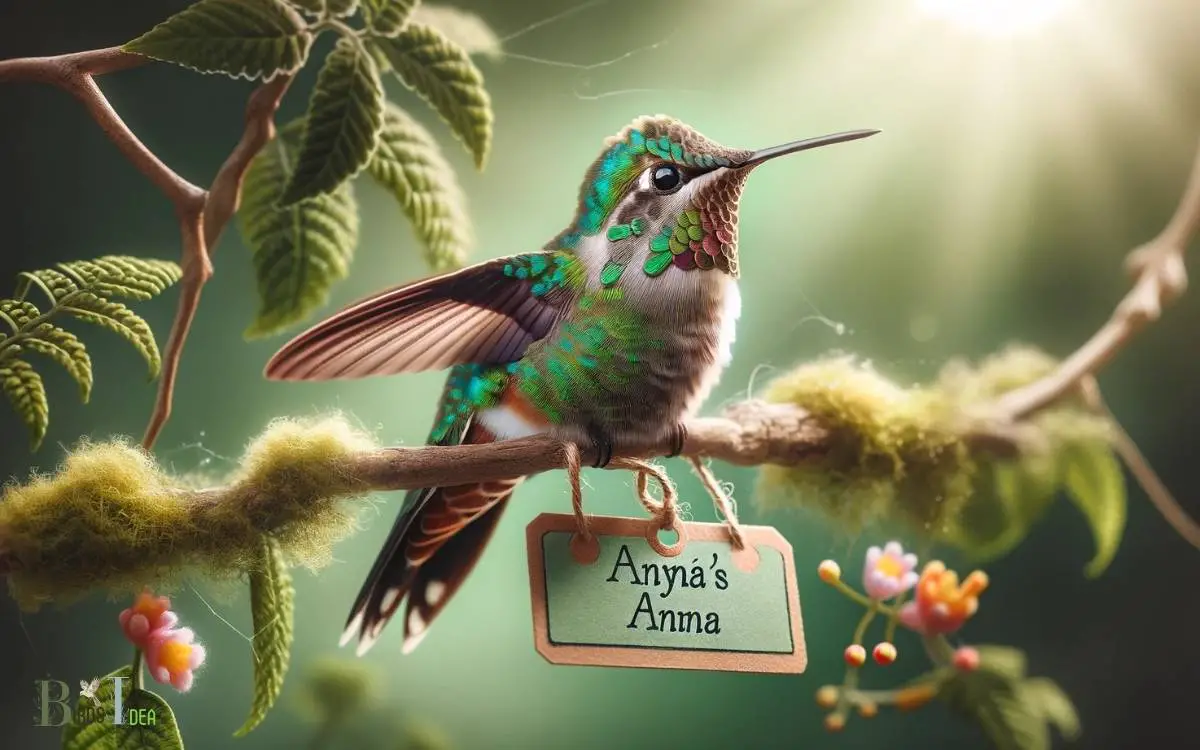
Key Takeaway
Taxonomy and Classification
The taxonomy and classification of Anna’s Hummingbird is based on its morphological and genetic characteristics, placing it within the family Trochilidae and the genus Calypte.
This small bird, commonly found along the western coast of North America, is known for its iridescent green feathers and vibrant pink head and throat feathers in males.
The classification of Anna’s Hummingbird is further categorized into different subspecies based on variations in their physical features and geographic distribution.
The taxonomic identification of this species enables scientists and researchers to better understand its evolutionary history, ecological niche, and conservation needs.
By classifying Anna’s Hummingbird within the broader context of avian taxonomy, it provides valuable insights into the diversity and adaptation of hummingbirds within the natural world.
Etymology of Calypte Anna
Calypte Anna’s etymology is derived from its taxonomic genus and species names, reflecting the distinct characteristics and historical significance of this particular hummingbird species.
The etymology of Calypte Anna is as follows:
- Calypte: The genus name “Calypte” is derived from the Greek word “kalyptō,” which means “to cover” or “to conceal.” This is a reference to the brilliant iridescent gorget or throat patch displayed by male Anna’s Hummingbirds during courtship displays.
- Anna: The species name “Anna” honors Anna Masséna, Duchess of Rivoli, a French socialite and amateur naturalist who was a contemporary of John James Audubon, the renowned ornithologist and painter.
The combination of these names encapsulates the unique physical features and historical context associated with the Calypte Anna species.
Historical Context of the Name
The historical context of the scientific name of Anna’s Hummingbird provides insight into its origin, significance, and the taxonomic naming process.
Understanding the cultural and regional influences that contributed to the naming of this species adds depth to our appreciation of its place in the natural world.
Exploring these facets sheds light on the intricate interplay between science, culture, and nature.
Origin and Significance
Originating from the early 19th century, the scientific name of Anna’s hummingbird holds historical significance in the field of taxonomy.
The name “Calypte anna” can be broken down to reveal its origin and significance:
- Genus Calypte: This genus name is derived from the Greek word “kalyptō,” meaning “to cover” or “to conceal.” It refers to the vibrant iridescent gorget (throat patch) found in male Anna’s hummingbirds, which can appear to be concealed when not in direct light.
- Species anna: The species name “anna” was chosen by renowned ornithologist René Lesson in honor of Anna Masséna, Duchess of Rivoli, a prominent figure in the scientific community and a patron of the arts during the 19th century.
- Taxonomic Significance: The scientific name “Calypte anna” not only reflects the physical characteristics of the species but also pays tribute to an influential supporter of scientific endeavors during that era.
Taxonomic Naming Process
During the taxonomic naming process, the scientific name ‘Calypte anna’ was carefully selected to reflect both the physical attributes of the species and to honor an influential figure in the scientific community.
The genus name ‘Calypte’ derives from the Greek word ‘kalyptō’, meaning ‘to cover’ or ‘to conceal’, which is a reference to the vibrant iridescent gorget or throat patch found on male Anna’s Hummingbirds.
This feature was likely a key factor in the selection of the genus name. The species name ‘anna’ pays tribute to Anna Massena, Duchess of Rivoli, a renowned amateur ornithologist and patron of natural sciences in the 19th century.
The taxonomic naming process, therefore, not only captures the physical essence of the species but also reflects the historical context and the influential figures in the scientific community.
Cultural and Regional Influences
An examination of the cultural and regional influences sheds light on the historical context of the name ‘Calypte anna’ for the Anna’s Hummingbird.
- Spanish Influence: The species was named after Anna Masséna, Duchess of Rivoli, a renowned 19th-century French noblewoman with strong ties to the scientific community.
- California Connection: The naming also reflects the bird’s primary habitat, as the Anna’s Hummingbird is predominantly found along the western coast of North America, particularly in California.
- Scientific Collaboration: The name ‘Calypte anna’ was proposed by renowned French ornithologist René Lesson, showcasing the collaborative nature of scientific naming and the historical international exchange of knowledge.
These cultural and regional influences provide valuable historical context, offering insight into the interconnectedness of science, society, and geography.
Significance in Ornithology
The Anna’s Hummingbird holds a significant place in ornithology due to its unique mating rituals and color-changing gorget feathers.
These distinctive behavioral and physical characteristics have captured the attention of researchers and bird enthusiasts, contributing to a deeper understanding of the species.
Exploring the significance of these traits in ornithology sheds light on the complex and fascinating nature of the Anna’s Hummingbird.
Unique Mating Rituals
In the study of ornithology, understanding the unique mating rituals of Anna’s hummingbird is crucial for comprehending the species’ reproductive behavior and social dynamics.
These rituals are fascinating and significant in ornithology for several reasons:
- Elaborate Courtship Displays: Male Anna’s hummingbirds perform intricate aerial displays, diving and ascending rapidly while producing buzzing sounds with their tail feathers to attract females.
- Female Selection Process: Females observe these displays and select mates based on the males’ performance, agility, and vigor, indicating the importance of these rituals in mate selection.
- Territory Defense: Males establish and defend territories where they perform these displays, and understanding this behavior provides insights into the species’ social structure and competition for resources.
These unique mating rituals not only contribute to the understanding of Anna’s hummingbird behavior but also hold broader implications for avian reproductive strategies.
Color-Changing Gorget Feathers
Color-Changing Gorget Feathers play a crucial role in the courtship displays of Anna’s hummingbirds, further illuminating the complexity of their mating rituals in ornithology.
The iridescent gorget feathers, located on the throat of male Anna’s hummingbirds, exhibit remarkable color changes during their courtship displays.
The vibrant iridescence is a result of microscopic platelets in the feathers that refract and reflect light, creating an optical illusion of shifting colors as the angle changes.
This remarkable feature serves as a visual signal during courtship, with the male using the changing colors to attract and court potential mates.
The ability of these feathers to reflect and display a wide range of colors is a fascinating adaptation that has captured the attention of ornithologists studying the intricate mating behaviors of Anna’s hummingbirds.
This unique feature is just one of many morphological characteristics that contribute to the remarkable behavior of Anna’s hummingbirds.
Morphological Characteristics
Anna’s Hummingbird displays distinctive morphological characteristics that distinguish it from other hummingbird species.
These include:
- Size: Anna’s Hummingbird is relatively small, measuring around 3.9 to 4.3 inches in length, with a wingspan of approximately 4.7 inches.
- Plumage: The male Anna’s Hummingbird is known for its vibrant iridescent pinkish-purple crown and gorget, while the female has a more muted coloration with green and grey feathers.
- Bill shape: This species has a straight and slender bill, which is adapted for feeding on nectar from flowers, as well as catching small insects.
These characteristics make the Anna’s Hummingbird easily recognizable and distinguishable from other hummingbird species, contributing to its unique and captivating appearance.
Behavioral Traits
Displaying territoriality, courtship behavior, and feeding patterns, Anna’s Hummingbird exhibits a diverse range of behavioral traits that contribute to its unique characteristics.
These tiny birds fiercely defend their feeding and nesting territories, often engaging in high-speed aerial chases to protect their space.
During courtship displays, males perform impressive aerial dives and produce loud, distinctive sounds with their tail feathers to attract females.
The feeding patterns of Anna’s Hummingbird are equally fascinating, as they consume floral nectar and small insects to meet their high metabolic demands.
These behavioral traits not only showcase the remarkable adaptability of this species but also highlight their importance in maintaining ecosystem balance.
Understanding these behaviors provides valuable insight into the intricate lives of Anna’s Hummingbirds.
Transitioning into the subsequent section, the habitat and distribution of these birds further elucidate their captivating nature.
Habitat and Distribution
Where do Anna’s Hummingbirds primarily inhabit and what is their geographical distribution?
- Primary Habitat: Anna’s Hummingbirds are primarily found along the western coast of North America, from southern Canada to northern Baja California in Mexico. They inhabit a variety of environments, including coastal scrub, chaparral, oak savannahs, and urban areas.
- Geographical Distribution: Their range includes regions such as California, Arizona, Nevada, Oregon, and Washington in the United States, as well as parts of western Canada and northern Mexico.
- Altitude: These hummingbirds can be found at varying altitudes, from sea level up to around 6,500 feet in their northern range and up to 9,800 feet in their southern range.
Anna’s Hummingbirds have adapted to a diverse range of habitats, allowing them to thrive across a wide geographical area.
This versatility has contributed to their population’s conservation status, which will be discussed in the subsequent section.
Conservation Status
Frequently, the conservation status of Anna’s Hummingbird is a topic of concern among researchers and environmental organizations due to ongoing threats to their habitats and population.
The International Union for Conservation of Nature (IUCN) Red List has categorized Anna’s Hummingbird as a species of Least Concern, indicating that the overall population trend is stable.
However, localized threats such as habitat loss due to urbanization, deforestation, and climate change continue to pose significant risks to this species.
Efforts to monitor and protect their habitats, promote native plant gardening, and raise awareness about the importance of conserving these charismatic birds are essential for their long-term survival.
| Threats | Conservation Status |
|---|---|
| Habitat Loss | Vulnerable |
| Climate Change | Endangered |
| Urbanization | Near Threatened |
| Deforestation | Least Concern |
Cultural and Symbolic Representations
Cultural and symbolic representations of Anna’s Hummingbird are deeply rooted in the indigenous traditions of the regions where they are found.
These representations hold significant cultural and spiritual meanings for the indigenous peoples and are often associated with various beliefs and folklore.
The hummingbird is revered for its agility, vibrant plumage, and unique behavior, which has led to its symbolic significance in various cultural contexts.
Symbolic Representations:
- Spiritual significance: In many indigenous cultures, the hummingbird is seen as a spiritual guide that brings joy, love, and good luck.
- Resilience and determination: The bird’s ability to hover in mid-air and move swiftly symbolizes resilience and determination.
- Connection to nature: The hummingbird often represents a deep connection to nature and the environment, emphasizing the importance of living in harmony with the natural world.
Conclusion
The Anna’s Hummingbird, known scientifically as Calypte Anna, holds a significant place in ornithology due to its unique morphological characteristics and behavioral traits.
Its name carries historical and cultural significance, and its habitat and distribution are important factors in its conservation status.
The bird’s symbolism extends beyond its physical form, representing resilience and adaptability in the face of adversity, making it a powerful and enduring symbol in the natural world.

